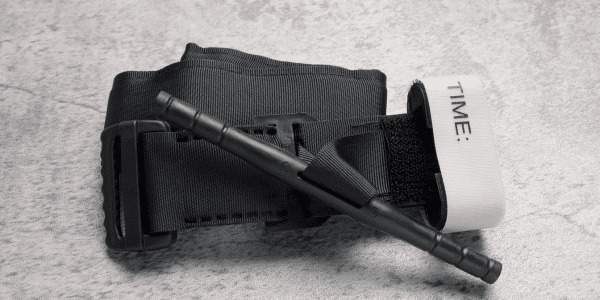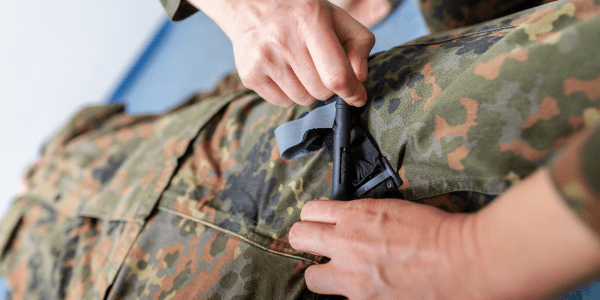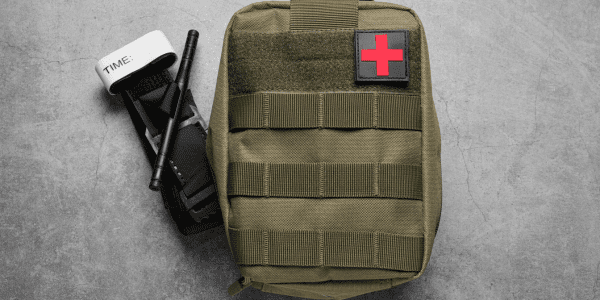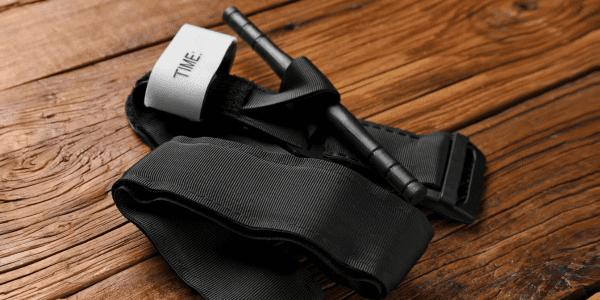Should You Carry a CAT Tourniquet as Part of Your EDC?
In the blink of an eye, life can take an unexpected turn. A seemingly ordinary day can transform into a chaotic scene where every second counts and quick thinking becomes the difference between life and death. While we can’t predict emergencies, we can arm ourselves with the tools that might make all the difference. What tool am I referring to? The CAT tourniquet.
The CAT tourniquet is an essential piece of kit that everyone should be carrying daily, and in this article, we are going to dive deeper into why carrying a CAT tourniquet should be a non-negotiable part of your daily preparedness, offering you the power to save lives when it matters most.
Unsure what a CAT tourniquet is or looks like? Here’s a link to view the tourniquet and even purchase one if you wish. And if you’re going to purchase a CAT tourniquet, get multiple so that you can stage them in bags and vehicles if you need one in an emergency.

Disclaimer: This article is for informational purposes only. It is not meant as medical advice, and you should learn and understand how to properly use a CAT tourniquet before you decide to carry one as part of your EDC.
Table of contents
- What is a CAT Tourniquet?
- This History of the CAT Tourniquet
- What Features Does the CAT Tourniquet Have That Varies from Other Tourniquets?
- Why Should You Carry a CAT Tourniquet as Part of Your EDC?
- How Can You Carry a CAT Tourniquet?
- How Do You Apply a CAT Tourniquet?
- No One is Coming to Save You or Those Around You — Be Prepared
What is a CAT Tourniquet?
A CAT tourniquet, also known as a Combat Application Tourniquet, is a medical device designed to control severe bleeding, particularly in emergency situations. It is specifically designed to be applied to limbs, such as arms or legs, where traumatic injuries and significant blood loss may occur.
The CAT tourniquet consists of a band or strap made of strong and durable material, often nylon, with a windlass system. The band is typically about one to two inches wide and long enough to wrap around a limb. The windlass system includes a windlass rod and a windlass clip to retain the windlass after tightening down on a limb.
Related Article: Snakestaff Systems ETQ: A Tourniquet You’ll Actually Carry?
To use the CAT tourniquet, the band is applied tightly around the injured limb above the bleeding site. Get the tourniquet as high and tight on the limb as possible. The free end of the band is threaded through the windlass clip, which acts as a locking mechanism. The windlass rod is then turned to tighten the band and increase pressure on the underlying blood vessels, effectively occluding blood flow. Once tightened, the windlass clip is secured to prevent accidental loosening.

The CAT tourniquet’s design allows for quick and effective application, even with one hand. It is lightweight, portable, and widely used in military, law enforcement, emergency medical services, and civilian settings where immediate bleeding control is crucial to prevent further harm and potentially save lives.
It’s important to note that while the CAT tourniquet is a valuable tool in managing severe bleeding, proper training on its correct application is essential to ensure effective and safe use.
This History of the CAT Tourniquet
The CAT tourniquet was developed in the early 2000s and has become one of the most widely used tourniquets in military and pre-hospital settings. The tourniquet was specifically designed to address the need for an effective, easy-to-use device to control extremity bleeding on the battlefield.
Related Article: Live the Creed — Impressive EDC & Battle Belt Med Kits
The development of the CAT tourniquet was driven by the recognition of the high incidence of preventable deaths caused by uncontrolled bleeding in military combat. Before the CAT’s introduction, traditional tourniquets were often difficult to apply under stressful conditions and failed to provide adequate pressure to effectively occlude blood flow. As a result, many soldiers died before the advent of the CAT tourniquet from wounds that, if treated properly, could have preserved life.
The CAT tourniquet was developed by Ted Westmoreland. The project began in 2001, and after several design iterations and extensive testing, the CAT tourniquet was approved for use by the US Army in 2005.
The CAT tourniquet features a number of innovations that contribute to its effectiveness. Its one-handed application design allows for self-application or application by a buddy, making it easier for soldiers to use in the field. When twisted, the windlass rod enables rapid and efficient blood flow occlusion. Additionally, the tourniquet is made of durable and lightweight materials, which makes it portable and suitable for use in challenging terrain and environments.
The CAT tourniquet has since gained widespread acceptance and has been credited with saving numerous lives. Its success in military applications has also led to its adoption by law enforcement, emergency medical services (EMS), and other healthcare settings, where it is used to control severe bleeding in civilian emergencies.
Related Article: Are Chest Seals Truly Necessary in Trauma Kits?
Today, a CAT tourniquet is among one of the most carried pieces of medical equipment for EDC and is found in range bags across the nation as a means of stopping a massive extremity bleed.
What Features Does the CAT Tourniquet Have That Varies from Other Tourniquets?
The CAT tourniquet features several design elements that set it apart from other tourniquets and make it particularly well-suited for emergency situations, such as massive wounds to the extremities where there is a significant loss of blood.

Below are some notable features of the CAT tourniquet and how it varies from other tourniquets on the market:
1. One-handed application
The CAT tourniquet is designed to be applied with one hand, allowing individuals to quickly and effectively apply it on their own extremities or on someone else’s. This is especially important in situations where the injured person is unable to use one arm or hand.
2. Windlass system
One of the most crucial differences with the CAT tourniquet is that it incorporates a windlass system consisting of a windlass rod and a windlass clip. The rod is used to tighten the tourniquet while the clasp secures the rod in place, maintaining the desired level of pressure. This mechanism enables precise and controlled tightening of the tourniquet, ensuring effective blood flow occlusion.
3. Velcro strap
The CAT tourniquet utilizes a Velcro strap that allows for easy and secure attachment around the limb. The strap can be adjusted and fastened quickly, providing a snug fit to achieve optimal compression on the underlying blood vessels.
4. Locking mechanism
Once the desired level of tightness is achieved, the CAT tourniquet features a locking mechanism that prevents accidental loosening or release. This ensures that the tourniquet remains securely in place, maintaining adequate pressure on the limb. In addition to the locking mechanism, a Velcro tab goes over the clasp to further secure the windlass in place.
5. Durability and portability
The CAT tourniquet is constructed from high-quality materials, such as durable nylon and a windlass rod made of strong polymer. These materials make the tourniquet lightweight, yet robust enough to withstand the rigors of combat or other demanding environments. The compact and portable design allows for easy storage and carrying in medical kits or individual first aid kits. Some individuals even EDC a CAT tourniquet in their back pocket or cargo pocket.
Why Should You Carry a CAT Tourniquet as Part of Your EDC?
For starters, I just want to throw this out there, and while it’s my personal opinion, many share the same thoughts and opinions as I have, and that’s you shouldn’t carry a TK4 tourniquet, SWAT-T, or a RATS tourniquet — ever (unless you want to use it as a pressure bandage). If it’s the only thing you have at your disposal to use in an emergency, use it, but know that it’s nowhere near as good as using a CAT tourniquet or SOF-T Wide tourniquet. This is based on my training and use of the various tourniquets, and you can’t change my mind. I’ve also done a review of the Snakestaff Systems ETQ, which I really like, but we had one fail at medical class I was in.
Additionally, if you carry a firearm daily and are willing to deploy it and send rounds down range, wouldn’t you think there’s a high probability that there may also be rounds coming back at you or the fact that another object, such as a knife, is in play, causing you to use deadly force to stop the threat? Therefore, if you’re willing to create holes and cause someone to bleed, you should also have ways to treat and stop bleeding.
That being said, carrying a CAT tourniquet can be beneficial for several reasons, especially in situations where there is a risk of severe bleeding. Here are some key reasons why it is recommended to carry a CAT tourniquet:
Rapid response to severe bleeding
Severe bleeding, particularly from extremity wounds, can lead to life-threatening situations if not controlled quickly. Having a CAT tourniquet readily available allows you to take immediate action and apply adequate pressure to stop the bleeding promptly, potentially saving lives.
Easy and quick application
The CAT tourniquet is designed for one-handed application, which means it can be applied by yourself or by someone else with minimal training. Its intuitive design and simple operation enable rapid deployment, even in high-stress situations.
Effective hemorrhage control
The CAT tourniquet uses a windlass system and Velcro strap to allow for precise tightening and secure attachment around a limb. This helps achieve sufficient compression on the blood vessels, effectively stopping blood flow to the injured limb.
Versatility and broad applicability
While initially developed for military use, the CAT tourniquet has gained widespread adoption in various settings. It is now commonly used by law enforcement, emergency medical services, and civilians in situations such as accidents, natural disasters, and mass casualty incidents. Carrying a CAT tourniquet ensures you have a versatile tool that can be used to address severe bleeding in diverse situations.
Portable and lightweight
The compact and lightweight design of the CAT tourniquet makes it easy to carry in personal first-aid kits, medical bags, or even pockets. Its portability ensures that you can have it readily available when needed, whether you’re in the field, at home, or in a public setting.
How Can You Carry a CAT Tourniquet?
There are several ways to carry a CAT tourniquet to ensure it is easily accessible when needed. Here are a few common methods:
1. Individual pouch or holder
Many manufacturers offer specialized pouches or holders designed specifically for carrying tourniquets. These pouches are typically attached to a belt, MOLLE webbing system, or carried on a vest or backpack. They securely hold the tourniquet and provide quick and easy access.
Here are some options:
- North American Rescue CAT Tourniquet Holder
- CAT Tourniquet Belt Attachment Case
- NcSTAR Tourniquet Pouch
2. Pocket or waistband carry
If you prefer a more discreet method, you can carry a CAT tourniquet in a pocket or secured to your waistband using a clip or elastic band. This method is suitable for smaller tourniquets and provides a convenient and inconspicuous way to carry them. If you don’t want extra gear or want to store the CAT tourniquet in anything, simply fold up your tourniquet and toss it in your pocket.
3. First aid kit or medical bag
If you have a larger first aid kit or medical bag, you can store the CAT tourniquet inside. Ensure that the tourniquet is easily accessible and not buried deep within the kit. Organize the contents of the bag in a way that allows for quick identification and retrieval of the tourniquet.
Here are some options:
4. Backpack or daypack
If you frequently carry a backpack or daypack, you can allocate a specific pocket or compartment to store the tourniquet. This ensures it is always with you during outdoor activities, travel, or everyday commuting.

Remember that the key is to have the CAT tourniquet easily accessible and not buried or hidden away. Consider your personal preferences, the activities you engage in, and the specific equipment or clothing you use to determine the best method of carrying the tourniquet for your needs. Additionally, ensure that you regularly inspect the tourniquet for any signs of damage or wear and replace it as needed to maintain its reliability.
How Do You Apply a CAT Tourniquet?
Here’s a step-by-step guide on how to apply a CAT tourniquet (it is still recommended that you take a medical class or get proper training from a professional):
1. Verify the need
Ensure that there is severe bleeding from an extremity (arm or leg) that cannot be controlled by direct pressure. A tourniquet should only be used in life-threatening situations where direct pressure alone is insufficient to stop the bleeding.
2. Prepare the CAT tourniquet
Open the CAT tourniquet completely, making sure it is not twisted. Locate the windlass rod (the stiff, plastic rod) and ensure that the Velcro strap is free of any obstacles.
3. Position the CAT tourniquet
Place the tourniquet high on the injured limb, between the wound and the heart. For example, if the wound is on the lower leg, place the tourniquet as high on the leg as possible but not over a joint.
4. Tighten the CAT tourniquet
Wrap the tourniquet around the limb, ensuring that the end with the clasp is on top and not obstructed by clothing or the body. Pass the free end of the tourniquet through the buckle if not already staged, and pull it tight. Pull the Velcro strap tightly and then secure it to itself, ensuring that the tourniquet is firmly held in place. Start twisting the windlass rod until the bleeding stops. You may need to rotate it several times. The tourniquet should be tightened until the bleeding ceases.
5. Lock the CAT tourniquet by securing the windlass rod
Once the bleeding has stopped, insert the windlass rod through the open slot in the clasp on top of the free end of the tourniquet. Place the Velcro tab over the opening to ensure the windlass stays in place and does not come out of the opening.
6. Write the time on the CAT tourniquet
Take a permanent marker and write the time on the tab of the tourniquet to notify emergency personnel as to the approximate time the tourniquet was applied to you or the individual.
7. Seek medical help
Once the tourniquet is applied, it is crucial to seek immediate medical attention. A tourniquet is a temporary measure and should not be left in place for an extended period. Inform medical professionals about the presence of a tourniquet and the time it was applied.
Below is a video explaining how to properly apply a CAT tourniquet:
Remember, applying a tourniquet is a critical skill, and it’s important to receive proper training on its use. This article is intended as an overview and does not replace hands-on instruction or professional medical advice. If you want to get some hands-on training, I highly recommend taking the Iron Forge Consulting Group Active Treat Medical Class (here is my review of the class).
If you were looking for medical classes to take, head over to Bulletn and put in your zip code to find out what classes are being held near you, or simply choose the medical class tab to see all the classes across the US.
I also had the opportunity to interview Jonathan Aldridge of Iron Forge Consulting Group, where he talked about TacMed, EDC, and many other topics.
No One is Coming to Save You or Those Around You — Be Prepared
Emergencies don’t wait for a convenient moment — they demand preparedness in the face of adversity. Carrying a CAT tourniquet empowers you to potentially save a life in a time of crisis. It grants you the opportunity to transform chaos into order and to stand tall as a first responder even before the professional first responders arrive.
So, as you venture out and about with your day, make room in your everyday carry for this remarkable tool — the CAT tourniquet — and be ready to face the unexpected with the knowledge that you possess the power to save lives when it matters most.
And remember, no one is coming to save you. You are your own protection detail and your own first responder. You can bleed out in as little as three minutes, well before medical personnel arrive. Carry a CAT tourniquet, and stay prepared!
It should also be noted that it’s important to have a dedicated training tourniquet to ensure you keep your other TQs new and ready at a moments notice in an emergency.
If you are looking to pick up a CAT tourniquet, click here for the best deal I’ve found.


*Disclosure: This article may contain affiliate links or ads, which means we earn a small commission at no extra cost to you if you make a purchase through these links. These commissions help support the operation and maintenance of our website, allowing us to continue producing free valuable content. Your support is genuinely appreciated, whether you choose to use our links or not. Thank you for being a part of our community and enjoying our content.
PLEASE CONSIDER SHARING THIS ON YOUR SOCIAL MEDIA TO HELP OTHERS LEARN MORE ABOUT THIS TOPIC. SIMPLY CLICK BELOW!

